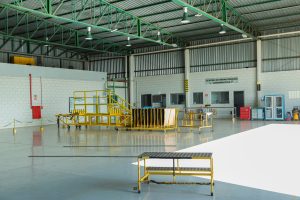Key Takeaways:
- Strategic Location: The strategic positioning of a military hangar enhances operational efficiency and security, ensuring quick deployment capabilities and protection against threats.
- Technological Integration: Incorporating advanced technologies in military hangars is crucial for optimizing maintenance, enhancing security, and improving energy efficiency.
- Sustainable and Adaptable Design: Effective military hangars combine robust security with flexibility and environmental sustainability, supporting various operational needs while meeting regulatory standards.
The design of a military hangar transcends typical architectural challenges, embodying a critical fusion of strategic necessity and technological sophistication. These structures are indispensable in safeguarding high-value military assets, facilitating efficient maintenance, and ensuring the rapid deployment capabilities essential for defense operations.
Consequently, their design requires a meticulous synthesis of security, functionality, and resilience to meet stringent military specifications. That said, this guide will meticulously outline the key considerations for designing a military hangar.
1. Strategic Location
The choice of location is one of the most critical decisions in the design of a military hangar. The strategic positioning of the hangar is essential to maximize operational readiness and efficiency. This involves considering the proximity to active military zones, ease of access for personnel and equipment, and the overall security of the area.
A well-located hangar reduces response times in crises and enhances the logistical support for military operations. Additionally, you should choose the location to minimize risks from natural disasters and enemy threats, balancing operational requirements with safety considerations.
2. Size And Capacity
The hangar’s size and capacity must be tailored to accommodate the specific types and numbers of aircraft expected to be housed, including provision for future fleet expansions. You must meticulously plan key dimensional aspects such as height, wingspan clearance, and hangar depth to ensure all aircraft fit comfortably and can be easily maneuvered within the space. This foresight in design prevents costly future modifications and ensures the hangar remains functional as military technology and aircraft specifications evolve.
3. Structural Durability
Durability is paramount in military hangar design due to the high value and strategic importance of the assets they protect. The structure must withstand various environmental stresses, such as extreme weather conditions, seismic activities, and potential military attacks. Using advanced, resilient building materials and construction techniques not only extends the hangar’s lifespan but also enhances its ability to protect sensitive military equipment under all circumstances.
4. Security Features
Security considerations encompass both physical and digital defenses to safeguard against unauthorized access, espionage, and sabotage. This includes the installation of comprehensive surveillance systems, secured entry points, and robust access control mechanisms. Additionally, cybersecurity measures are crucial to protect communication and data systems from hacking and other forms of cyber-attacks. The security infrastructure must be adaptable to evolving threats and incorporate redundancy to ensure continuous operation even under adverse conditions.
5. Technological Integration
Integrating advanced technologies is essential for modern military hangars. Automation in maintenance processes, state-of-the-art diagnostics systems, and logistics support are critical for operational efficiency. Smart technologies can help manage energy use, control internal environments, and enhance the speed and quality of aircraft maintenance tasks. This technological backbone must be reliable and compatible with the military’s existing systems to maximize functionality.
6. Environmental And Energy Efficiency
Designing with environmental consciousness is increasingly important. Military hangars should strive for sustainability by incorporating energy-efficient technologies, renewable energy sources, and sustainable building materials. You should also integrate efficient waste management systems and water conservation practices. These measures not only help in reducing the operational carbon footprint but also ensure compliance with environmental regulations and contribute to long-term cost savings.

7. Regulatory Compliance
Military aircraft hangar projects are subject to stringent regulatory standards covering everything from construction safety to environmental protection and operational security. Compliance must be an integral part of the design and construction processes to avoid legal and operational setbacks. Understanding and integrating these regulations from the outset simplifies the approval processes and ensures that the hangar meets all necessary guidelines for military use.
8. Cost Management
Budget constraints are a common challenge in military infrastructure projects. Effective cost management involves careful planning, transparent procurement processes, and ongoing budget oversight. The use of cost-effective materials and construction methods that do not compromise quality or security is essential. Strategic planning can help identify potential cost overruns early in the process, allowing for timely adjustments without impacting the overall project timeline or quality.
9. Flexible Design For Multiple Uses
A military hangar serves various functions beyond just housing aircraft. It may be used for maintenance, repairs, assembly, and storage. The design should therefore be versatile, allowing for different activities without requiring significant modifications. This flexibility ensures that the hangar can adapt to changing needs and technologies without extensive redesign or construction.
10. Project Management
Strong project management is crucial to ensure that the hangar construction is completed on schedule, within budget, and according to specifications. This involves coordinating with multiple stakeholders, including military personnel, contractors, and regulatory bodies. Effective project managers facilitate clear communication, resolve conflicts, and ensure that all parts of the project align with the strategic goals of the military organization.
11. Fire Safety And Suppression
Given the presence of fuel, lubricants, and other flammable materials, fire safety is paramount in hangar design. This includes the installation of advanced fire suppression systems tailored to the specific risks associated with military aircraft and equipment. Designs should incorporate comprehensive fire detection and response systems, including sprinklers, fire alarms, and easy access to emergency services.
12. Noise And Vibration Control
Military aircraft operations generate significant noise and vibrations, which can affect both the structural integrity of the hangar and the surrounding environment. Incorporating soundproofing materials and designing the military aircraft hangar to mitigate vibrations are essential to protect both personnel and equipment. This includes specialized acoustic treatments and vibration-dampening technologies that also contribute to operational secrecy.
Conclusion
By considering factors such as noise control, fire safety, modular construction, and staff amenities, designers can create a military aircraft hangar that not only protects valuable military assets but also supports the well-being and efficiency of the personnel who operate within its walls. Ultimately, the goal is to build a robust, adaptable, and secure environment that upholds the standards of modern military readiness and contributes to the overall effectiveness of national defense strategies.

Avid music fanatic. Communicator. Social media expert. Award-winning bacon scholar. Alcohol fan.

